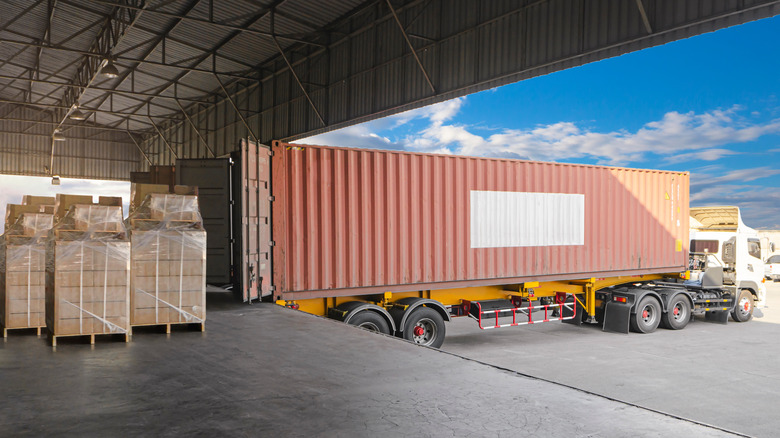Why Are Almost All Semi-Trailers 53 Feet Long?
Semi-trucks can come in all shapes and sizes, dictated largely by their intended purpose. Take one of the largest semi-trucks in existence, for example, which is dubbed the 'Red Giant.' This is a customized Diamond Reo Truck, and with a total length of around 93 feet, it's commonly regarded as one of the longest operational semi-trucks in America. Outside of the U.S., beasts such as the Australian road trains and the behemoth that is the Tractomas TR 10 x 10 D100 exist, but they're hardly the norm.
Instead, most semi-trucks in the U.S. are around 72 feet long, and most commonly they'll be sporting a trailer that's 53 feet in length. This hasn't always been the way, as the typical length used to be 48 feet. Regulation changes during the 1980s saw this change though, and ever since, 53 feet trailers have become the standard. This is predominantly because it's the perfect length for carrying a load full of pallets. Though not everything ships on pallets, a large proportion of goods do, and 53 feet long semi-trailers work perfectly for these common scenarios. Interestingly, 53 feet is also the minimum length mandated by current regulations for a semi-trailer, although the minimum requirement for older trailers does vary, according to "grandfather" laws.
Here's why a 53 foot long semi-trailer is great for hauling pallets
Almost everything in the U.S. is shipped on standard pallets, and those standard pallets have a dimension of 48 inches long by 40 inches wide. By doing the math, it can be calculated that 13 rows of pallets can fit perfectly on a semi-trailer 53 feet in length. There are two pallets in a row, meaning a 53 foot trailer can squeeze 26 pallets on. It isn't too tight, either, leaving roughly a foot of excess behind to ensure the door can close without snagging at the end. The last thing a truck driver needs is to load 13 rows of pallets, just to find the door doesn't close by an inch, as they would then need to rearrange the entire load. This is why 53 feet makes perfect sense.
The old 48 foot long semi-trailers wouldn't be able to get the same amount of pallets on, whereas a slightly longer trailer — say one of 55 feet — wouldn't be able to load any more, and therefore the excess length is just unused real estate. Regardless of how many pallets can fit on, truckers do need to be wary of weight limitations, also. If the pallets are particularly heavy, fewer rows may be necessary, or they may need to be transported with lighter pallets either side of them, in order to distribute the weight evenly (and pass those weigh stations). There are various different types of semi-trailers, too, and for obscure weight loads, potentially a specialist trailer would be better suited than a traditional 53-footer.

